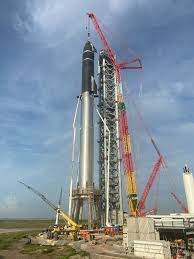

Once again, things are gearing up at SpaceX’s South Texas Launch Facility, located just outside the village of Boca Chica, Texas. In recent weeks, the aerospace community has been abuzz about the rollout and Static Fire test of the Super Heavy Booster 3 (B3) prototype. This was the first time a booster was tested, which will be responsible for launching the Starship to space in the near future. Since then, things have only ramped up some more.
First, there was the announcement on Aug. 2nd that the fourth Super Heavy prototype (the BN4) received a full complement of 29 Raptor engines and grid fins. This was followed on Aug. 3rd with news that BN4 was being moved to the launch pad and that the SN20 Starship prototype received a full six Raptor engines. On Aug. 6th, the denouement came with the stacking of both prototypes together, which resulted in the tallest rocket in the history of spaceflight!
Together, the integrated Starship stood around 120 meters (390 feet) tall, while the addition of the orbital launch stand increased that to 145 m (475 feet) – which is taller than the Pyramid of Giza (138.5 m; 454 ft). The stacking was the first time that the Starship and Super Heavy were fully integrated, a major milestone for the company that puts them one step closer to making an orbital flight test.
History has been made. The world’s tallest rocket… ever ???? pic.twitter.com/FZKNbWewZg
— Everyday Astronaut (@Erdayastronaut) August 6, 2021
The integration was part of an accelerated work order that came to be nicknamed the “Warp 9” surge. This included bringing hundreds of employees in from other sites around the country to assist in operations. By Friday, Aug. 6th, The two elements were integrated just long enough to get a sense of how they would hold up on flight day; and, of course, for observers to take millions of pictures, shoot videos, and live-tweet the event!
They were then unstacked, and the SN20 was returned to the High Bay while the BN4 remained on the orbital launch stand. Next, the two elements are expected to undergo a series of ground tests, which will likely include Static Fire tests for the BN4 booster. This will allow the company to complete and integrate the final elements of the Starship at the Orbital Launch Site (OLS), which is where it will launch to conduct the orbital test flight.

While no date has been set for this crucial milestone yet (though it is still expected before the end of the year), Musk indicated via Twitter that he and his company had four major objectives scheduled for the next two weeks. These include adding the last of the heat shield tiles to the Orbital Starship element, applying thermal protection to the booster engines, the addition of ground propellant storage tanks, and a quick disconnect (QD) arm for the system.
This last element is crucial to flight tests since it connects power and fuel lines from the launch facility to the rocket prior to launch. It is also clear at this juncture that the orbital flight test will be made with the BN4 and SN20 prototypes. This was made evident from the way the BN4 was equipped with 29 Raptor engines, which is what the final design specifications call for (the Static Fire test with the B3 consisted of just three).
29 Raptor engines and 4 grid fins have been installed on Super Heavy ahead of first orbital flight pic.twitter.com/XHkCZ9VYK4
— SpaceX (@SpaceX) August 3, 2021
Similarly, the SN20 has been equipped with a full six Raptor engines, three optimized for sea-level thrust (identical to the 29 engines the Super Heavy relies on), and three optimized for thrust in the vacuum of space. In all previous flight tests, the prototypes were equipped with only three engines optimized for sea-level thrust since they were making a limited flight test (10 km; 6.2 mi in altitude) and flying strictly within Earth’s atmosphere.
This is known as the Karman Line, which is about 100 km (62 mi) above sea level and marks the boundary between Earth and space. Another indication is the way Grid Fins were installed on the BN4, which is the first prototype to receive them. These are essential to making a controlled descent and landing for all SpaceX boosters, which shows that the ground crews are hoping to retrieve it afterward.

Based on the flight plan SpaceX filed with the FCC back in May, the mission will see the booster element separate from the Starship approximately 170 seconds into flight. The Booster will then perform a partial return and make a soft splashdown roughly 32 km (20 miles) offshore in the Gulf of Mexico. The Starship will then achieve orbit before performing a targeted soft splashdown about 100 km (62 mi) off the coast of the Hawaiian island of Kauai.
Based on previous statements, the flight is also likely to have a ceiling of 200 km (~125 mi) above sea level. If that test goes as planned, SpaceX will be ready to embark on its first commercial flights, which include a lunar flyby planned for 2023. Known as the #dearMoon campaign, this flight will see Japanese billionaire and art collector Yusaku Maezawa and a crew of eight artists fly around the Moon.
Given the recent buzz about Branson and Bezos, it’s possible Musk might want to fly along with them! Be sure to check out this video of the SN20 and BN4 getting stacked together as well, courtesy of NASA Spaceflight: